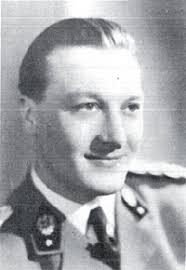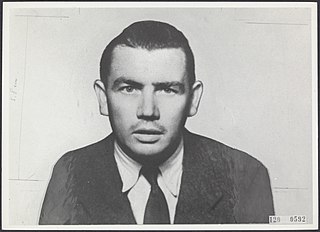Special Operations Executive (SOE) was a British organisation formed in 1940 to conduct espionage, sabotage and reconnaissance in German-occupied Europe and to aid local resistance movements during World War II.
Henriette Roosenburg was a Dutch Partisan, journalist and political prisoner. Her memoir The Walls Came Tumbling Down described her attempts to return to the Netherlands from Germany after being released from prison at the end of World War II. Born in the Netherlands to an upper-class family, she was a graduate student at the University of Leiden at the start of World War II and became a courier in the Dutch resistance, where she served under the code name Zip. During this time she also wrote for the Dutch newspaper Het Parool. In 1944 she was caught and sentenced to death, and became a Night and Fog prisoner in a German prison at Waldheim.

Countess Andrée Eugénie Adrienne de Jongh, called Dédée and Postman, was a member of the Belgian Resistance during the Second World War. She organised and led the Comet Line to assist Allied soldiers and airmen to escape from Nazi-occupied Belgium. The airmen were survivors of military airplanes shot down over Belgium or other European countries. Between August 1941 and December 1942, she escorted 118 people, including more than 80 airmen, from Belgium to neutral Spain from where they were transported to the United Kingdom. Arrested by the Nazis in January 1943, she was incarcerated for the remainder of World War II. After the war, she worked in leper hospitals in Africa.

Major General Count Albert-Marie Edmond Guérisse was a Belgian Resistance member who organized French and Belgian escape routes for downed Allied pilots during World War II under the alias of Patrick Albert "Pat" O'Leary, purportedly the name of a peace-time Canadian friend. His escape line was dubbed the Pat O'Leary Line.
Jack Charles Stanmore Agazarian, code name Marcel, was an agent for the United Kingdom's clandestine Special Operations Executive (SOE) organization in France during World War II. The purpose of SOE was to conduct espionage, sabotage, and reconnaissance in countries occupied by Nazi Germany and other Axis powers. SOE agents allied themselves with French Resistance groups and supplied them with weapons and equipment parachuted in from England. Agazarian was a wireless operator with the Prosper network based in Paris.

Despite Dutch neutrality, Nazi Germany invaded the Netherlands on 10 May 1940 as part of Fall Gelb. On 15 May 1940, one day after the bombing of Rotterdam, the Dutch forces surrendered. The Dutch government and the royal family relocated to London. Princess Juliana and her children sought refuge in Ottawa, Canada until after the war.
MI9, the British Directorate of Military Intelligence Section 9, was a secret department of the War Office between 1939 and 1945. During World War II it had two principal tasks: assisting in the escape of Allied prisoners of war (POWs) held by the Axis countries, especially Nazi Germany; and helping Allied military personnel, especially downed airmen, evade capture after they were shot down or trapped behind enemy lines in Axis-occupied countries. During World War II, about 35,000 Allied military personnel, many helped by MI9, escaped POW camps or evaded capture and made their way to Allied or neutral countries after being trapped behind enemy lines.

The Belgian Resistance collectively refers to the resistance movements opposed to the German occupation of Belgium during World War II. Within Belgium, resistance was fragmented between many separate organizations, divided by region and political stances. The resistance included both men and women from both Walloon and Flemish parts of the country. Aside from sabotage of military infrastructure in the country and assassinations of collaborators, these groups also published large numbers of underground newspapers, gathered intelligence and maintained various escape networks that helped Allied airmen trapped behind enemy lines escape from German-occupied Europe.

Jacques Desoubrie was a double agent who worked for the Gestapo during the German occupation of France and Belgium during World War II. He infiltrated resistance groups, such as the Comet Line, and was responsible for the arrest of several leaders and more than 100 members of organizations. The lines helped Allied airmen who had been shot down or crash-landed to evade German capture and escape occupied Europe. After the war he was tried, convicted, and executed in France.

The Free Belgian forces were soldiers from Belgium and its colonies who fought as part of the Allied armies during World War II, after the official Belgian surrender to Nazi Germany. It is distinct from the Belgian Resistance which existed in German-occupied Belgium.
Paul Colin was a Belgian journalist, famous as the leading journalist and editor of the Rexist collaborationist newspapers "Le Nouveau Journal" and "Cassandre".

Francis Alfred Suttill DSO, code name Prosper, was an agent of the United Kingdom's clandestine Special Operations Executive (SOE) organization in World War II. Suttill was the creator and organiser (leader) of the Physician or Prosper network in and around Paris, France, from October 1942 until June 1943. The purpose of SOE was to conduct espionage, sabotage and reconnaissance in occupied Europe and Asia against the Axis powers, especially Nazi Germany. SOE agents allied themselves with French Resistance groups and supplied them with weapons and equipment parachuted in from England.

The Comet Line was a Resistance organization in occupied Belgium and France in the Second World War. The Comet Line helped Allied soldiers and airmen shot down over occupied Belgium evade capture by Germans and return to Great Britain. The Comet Line began in Brussels where the airmen were fed, clothed, given false identity papers, and hidden in attics, cellars, and people's homes. A network of volunteers then escorted them south through occupied France into neutral Spain and home via British-controlled Gibraltar. The motto of the Comet Line was "Pugna Quin Percutias", which means "fight without arms", as the organization did not undertake armed or violent resistance to the German occupation.

Harold Cole, also known as Harry Cole,Paul Cole, and many other aliases, was a petty criminal, a confidence man, a British soldier, an operative of the Pat O'Leary escape line, and an agent of Nazi Germany. In 1940 and 1941, he helped many British soldiers escape France after its surrender to Nazi Germany in World War II. He became a double agent for the Germans in December 1941 and betrayed to the Gestapo 150 escape line workers and members of the French Resistance, of whom about 50 were executed or died in German concentration camps.

Christiaan Antonius Lindemans was a Dutch double agent during the Second World War, working under Soviet control. Otherwise known as Freddi Desmet, a Belgian army officer and SOE agent with security clearance at the Dutch Military Intelligence Division of the SOE (MID/SOE). He was known by the soubriquets "King Kong" or in some circles as "le Tueur" as he was reportedly ready to shoot at the slightest provocation. There is speculation that Lindemans was a member of Colonel Claude Dansey's Z organisation.

Despite being neutral at the start of World War II, Belgium and its colonial possessions found themselves at war after the country was invaded by German forces on 10 May 1940. After 18 days of fighting in which Belgian forces were pushed back into a small pocket in the north-west of the country, the Belgian military surrendered to the Germans, beginning an occupation that would endure until 1944. The surrender of 28 May was ordered by King Leopold III without the consultation of his government and sparked a political crisis after the war. Despite the capitulation, many Belgians managed to escape to the United Kingdom where they formed a government and army-in-exile on the Allied side.

The Shelburne Escape Line (1944) was a resistance organisation in occupied France in the Second World War. The Shelburne Line, financed by the British intelligence agency MI9, helped Allied airmen shot down over France evade capture by the occupying Germans and return to Great Britain by boat from the coast of Brittany. For the Allies, the rescue of downed airmen had a practical as well as a humanitarian objective. Training new and replacement air crews was expensive and time-consuming. Rescuing downed aircrew and returning them to duty became a priority.

Micheline Aline Dumon, , was a member of the Belgian Resistance during World War II with the Comet Line. Her surname often appears misspelled as "Dumont" in historical sources. She was awarded the British George Medal and United States Medal of Freedom for helping allied airmen shot down over Belgium and France evade capture and imprisonment by Nazi Germany. As a member of the Comet Line, founded by Andrée de Jongh, she aided in the escape of more than 250 allied airmen. She guided downed airmen from Belgium and France to the border of neutral Spain from where they could be repatriated to Great Britain.

The Pat O'Leary Line was a resistance organization in France during the Second World War. The Pat O'Leary escape line helped Allied soldiers and airmen stranded or shot down over occupied Europe evade capture by Nazi Germany and return to Great Britain. Downed airmen in northern France and other countries were fed, clothed, given false identity papers, hidden in attics, cellars, and people's homes, and escorted to Marseille, where the line was based. From there, a network of people escorted them to neutral Spain. From Spain, British diplomats sent the escapees home from British-controlled Gibraltar. Many different escape lines were created in Europe of which the Pat Line was the oldest and one of the most important. Collectively, the many escape lines helped 7,000 Allied military personnel, mostly airmen, escape occupied France, Belgium, and the Netherlands. The Pat Line received financial assistance from MI9, a British intelligence agency.

Escape and evasion lines in World War II helped people escape European countries occupied by Nazi Germany. The focus of most escape lines in Western Europe was assisting British and American airmen shot down over occupied Europe to evade capture and escape to neutral Spain or Sweden from where they could return to the United Kingdom. A distinction is sometimes made between "escapers" and "evaders". Most of those helped by escape lines were evaders.













